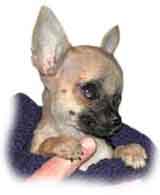Small Dog BreedsInformation About The Japanese Chin Dog Breed |
|
|
The Japanese Chin (also known as Japanese Spaniel) has a small and square body with a face that is pushed-in and puggish and protruding eyes. This breed can be easily mistaken for the Pekingese, and some believed that the 2 breeds may have evolved from a common stock. What makes the Japanese Chin different from the Pekingese is his more graceful movement that is taller on the leg and has a much lighter body. This breed is a spaniel and shares common traits with the King Charles Spaniel that also originated in Japan. However, he has more of a perky confidence than the slower-moving spaniel. He is full of life but a very dignified little oriental that enjoys being the center of attention. He is happy, affectionate, hardy, playful, easy going, and a loyal family pet. He is wary of strangers and can be mildly stubborn, but he usually responds to patient and persistent training. He needs to be socialized at an early stage in order to help build his confidence. He is usually good with children, although he may not tolerate their commotion and roughhousing. Spoiling this breed creates a controlling, nippy, and insecure dog. He can be difficult to housebreak and can easily damage his protruding eyes on a leash or a door. Size: This breed stands about 8-9in at the shoulder and weighs approximately 4-8lb. History and origin: The Japanese Chin was developed in China and introduced into Japan centuries ago. For over 1000 years, he was a favorite of the Japanese emperors that one of them even decreed that all Japanese Chins should be worshipped. Some tiny varieties were even kept in hanging cages in the same manner as small oriental birds. The breed eventually found his way to Europe with returning seamen during the 19 th century. However, the Japanese Chin did not make his appearance in the British show ring until 1862 and is not recorded as being shown in the United States until 20 years later. A couple of Japanese Chins were presented to Queen Victoria by Commodore Perry on his return from the Far East in 1853, which contributed to the popularity of the breed. Feeding: Recommended feeding for this breed is 6-8oz of cooked mince beef or ½ can (13.3oz size) of high-quality brand of dog food with plenty of dog biscuits. He also enjoys lean meat scraps and occasional non-splintery bones. Exercise: This is an easygoing breed that is ideal for apartment living provided he is walked once or twice a day. He likes to climb and would need extra care to make sure he does not fall off from high places. Grooming: His long, straight, and silky coat sheds and requires daily brushing with a pure bristle brush. He also needs an occasional trim to keep his coat in good condition.Back to the Small Dog Breed page
| |
|
Related News About Dogs ' ); // get rid of newsfeed display by carp CarpConf('poweredby',''); CarpCacheShow('http://www.small-dog-info.com/support-files/rss.xml'); ?>
|
|
|
|
|
|
Copyright © 2006-2007 dogguidance.com |


